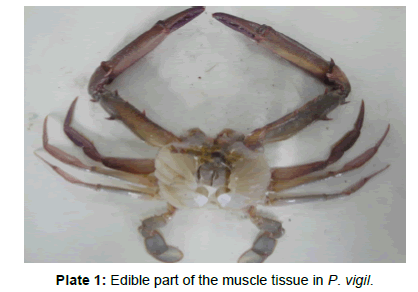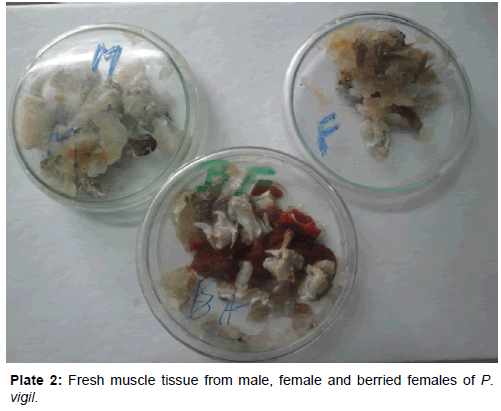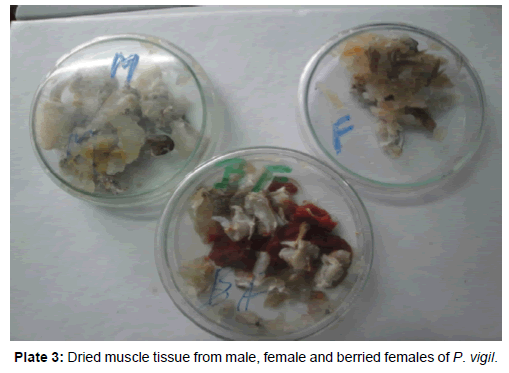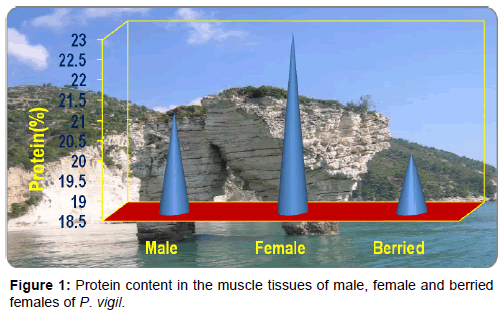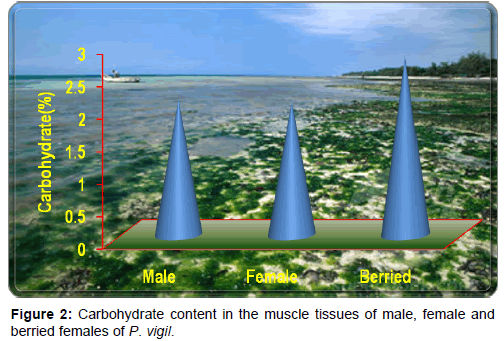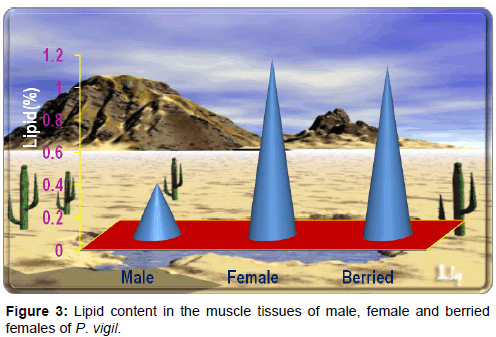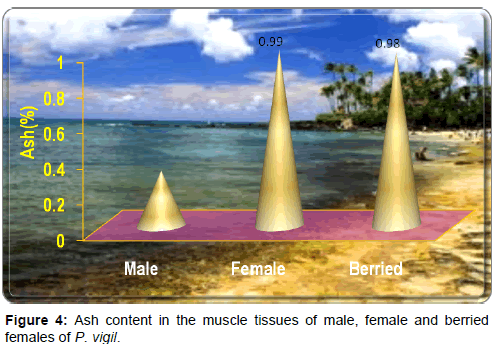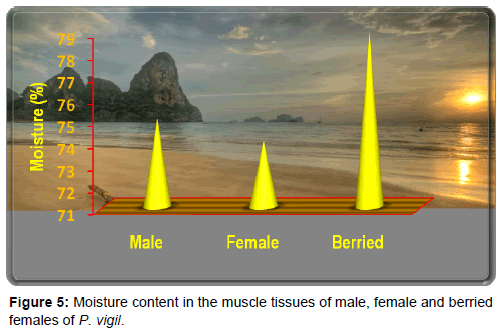Research Article Open Access
Biochemical Composition of Edible Crab, Podophthalmus Vigil (Fabricius)
Soundarapandian P1*, Ravichandran S2 and Varadharajan D1
1Faculty of Marine Sciences, Centre of Advanced Study in Marine Biology, Annamalai University, Parangipettai - 608 502, Tamil Nadu, India
2Department of Zoology, Government Arts College, Kumbakonam, Tamil Nadu, India
- *Corresponding Author:
- P Soundarapandian
Faculty of Marine Sciences
Centre of Advanced Study in Marine Biology
Annamalai University, Parangipettai-608 502
Tamil Nadu, India
Tel: 04144-243223
Fax: 04144-243553
E-mail: soundsuma@gmail.com
Received date March 06, 2013; Accepted date April 15, 2013; Published date April 20, 2013
Citation: Soundarapandian P, Ravichandran S, Varadharajan D (2013) Biochemical Composition of Edible Crab, Podophthalmus Vigil (Fabricius). J Marine Sci Res Dev 3:119. doi: 10.4172/2155-9910.1000119
Copyright: © 2013 Soundarapandian P, et al. This is an open-access article distributed under the terms of the Creative Commons Attribution License, which permits unrestricted use, distribution, and reproduction in any medium, provided the original author and source are credited.
Visit for more related articles at Journal of Marine Science: Research & Development
Abstract
Study of proximate composition in different sexes is important to know the nutritional status of each sex. In the present study, biochemical composition (protein, carbohydrate and lipid) were studied male, female and berried crabs of Podophthalmus vigil. The protein content was maximum in females (23.47%) when compared to males (21.53%) and berried females (20.93%). The carbohydrate content was significantly higher in berried females (2.76%) and lesser in males (2.09 %) and females (2.06%). The lipid contents were significantly higher in females (1.09%) and berried females (1.05%) than males (0.32%). Ash content was maximum in females (0.99%) and berried female (0.98%) than males (0.31%). The moisture content was maximum in berried females (79%) followed by males (75%) and females (74%). From the results, it is confirmed that organic constituents of the females are nutritionally superior over male crabs.
Keywords
Long eyed swimming crab; Protein; Carbohydrate; Lipid; Biochemical compositions
Introduction
Seafood is easily digestible because it has very little connective tissue. For that reason, fish is recommended in many special diets. The knowledge of the chemical composition of any edible organisms is extremely important since the nutritive value is reflected in its biochemical contents. A newer species should be recommended for human consumption only after assessing the nutritive value of the species with regards to its nutritional merits. Even though large numbers of marine crabs are suitable for human consumption, our knowledge on its nutritive value is fragmentary. A lot of studies examined the proximate composition of different crab species in different part of the world viz., C. maenas [1], P. pelagicus[2], queen crab, Chionoecetes opilio [3], P. pelagicus and P. sanguinolentus [4], S. serrata [5,6], C. longimanus [7], deep water crabs, M. simithi and Chaceon affinis [8], Mesopodopsis slabberi [9], S. tranquebarica [10,11], C. lucifera [12] and P. sanguinolentus [13]. However, available data on the proximate composition of crab Podopthalmus vigil are limited. So in the present study, an attempt has been made to evaluate the nutritional status of the edible portunid crab P. vigil.
Materials and Methods
The male, female and berried females of Podophthalmus vigil were procured from Parangipettai (Lat. 11°21’ N; Long. 79° 46’ E) landing centers. The carapace of the crabs was opened and the edible parts of muscle tissues were removed with sharp forceps (Plates 1-3). The removed muscle tissues were homogenized with pestle and mortar. The grounded muscles were then freeze dried and powdered and eventually stored in refrigerator for further analysis. The protein [14], carbohydrate [15], lipid [16], ash and moisture contents were estimated by adopting the standard method.
Statistical Analysis
The data were subjected to One-way analysis of variance (ANOVA) and difference between means were determined by Duncan’s multiple range tests (p<0.05) using SPSS version 17.0.
Results
Protein
The protein content was maximum in females (23.47 ± 0.36) when compared to males (21.53 ± 0.16) and berried females (20.93 ± 0.14). The protein values were significantly different between different sexes (Table 1 and Figure 1).
| Constituents | Male | Female | Berried |
|---|---|---|---|
| Protein | 21.53b ± 0.16 | 23.47a ± 0.36 | 20.93c ± 0.14 |
| Carbohydrate | 2.09b ± 0.22 | 2.06b ± 0.10 | 2.76a ± 0.24 |
| Lipid | 0.32b ± 0.10 | 1.09a ± 0.20 | 1.05a ± 0.22 |
| Ash | 0.31b ± 0.12 | 0.99a ± 0.11 | 0.98a ± 0.28 |
| Moisture | 75.0b ± 0.18 | 74.0c ± 0.23 | 79.0a ± 0.23 |
Different superscripts in a row are significantly different (P<0.05).
Table 1: Proximate composition of the muscle tissues of male, female and berried females (P. vigil). Values are expressed in % on dry weight basis except moisture. (Values are mean of three values ± SE).
Carbohydrate
The carbohydrate content was significantly higher in berried females (2.76 ± 0.24) and lesser in males (2.09 ± 0.22) and females (2.06 ± 0.10). However, according to Duncan’s multiple range tests, the carbohydrate values of malse and females were not significantly different (Table 1 and Figure 2).
Lipid
The lipid contents were significantly higher in females (1.09 ± 0.20) and berried females (1.05 ± 0.22) than males (0.32 ± 0.10). But the lipid contents were very similar both berried females and females (Table 1 and Figure 3).
Ash
Ash content was maximum in females (0.99 ± 0.11) and berried females (0.98 ± 0.28) than males (0.31 ± 0.12). But the values were not significantly varied between females and berried females (Table 1 and Figure 4)
Moisture
The moisture content was maximum in berried females (79 ± 0.23) followed by males (75 ± 0.18) and females (74 ± 0.23). The differences were statistically significant (Table 1 and Figure 5).
Conclusion and Discussion
The protein performs a wide range of functions and provides energy of 5.65 Kcal/g. The recommended dietary allowance (RDA) for protein is 1 g/kg body weight (adults). The protein requirements vary with age, physiological status and stress. More proteins are utilized by growing infant’s children, pregnant women, lactating women and individuals during infections and illness or stress. In the present study, protein content was higher in females (23.47%) than that of males (21.53%) and berried females (20.93%). Similar trend was already reported in freshwater prawns, Macrobrachium idella idella [17], M. idae [18], M. scabriculam [19] and in crab, S. serrata [20]. The fall in protein content, which is very well pronounced in berried females suggested that the protein in the muscle may be mobilized for the gonadal development. Similar trend was observed by Sriraman [21] in shrimp, Penaeus merguiensis and in freshwater prawn, M. idae. The females of P. indicusand Metapenaeus monoceros were increasingly proteinacious than males. Almost similar values of protein were already reported in P. vigil (15.75 to 20.16%) by Radhakrishnan and Natarajan [22] and in C. affinis was 17.8% [8]. Observed the protein content in S. serrata with egg (19.16%), without egg (20.92%), body meat (16.8%) and claw meat (16.28%) [23-25]. In S. serrata, the protein content of the body meat and claw meat was 20.11% and 18.54% respectively [5].
The protein content of various crabs was reported by different authors. The protein content of P. pelagicus and P. sanguinolentus was 0.47 to 15.91% and 12.81 to 13.6% respectively [24]. It was noticed that the protein values in cooked crab of S. serrata were ranged from 14.43 to 18.96% [25]. It was reported that the protein value in blue crab was 17.17% [26]. The assessed protein values in C. smithii were 59.8 to 71% in dry matter basis [27]. The protein values in S. tranquebarica were recorded from different parts viz., body meat (65.48 to 72.24%), claw meat (69.5 to 80.29%) and leg meat (69.47 to 74.7%) [10]. The protein content in S. tranquebarica varied between 67.62-72.47% [11]. The protein content in P. sanguinolentus was 32.6% [13] and 41.64% protein content was recorded in C. lucifera [12].
Carbohydrates are chemically defined as aldehyde or ketone derivatives of higher polyhydric alcohols. In the present study, carbohydrate content was higher in berried females than in males and females. Similar observations were made in prawns M. idae [18] and M. scabriculam [19]. The previous studies were suggested that the carbohydrate in the muscle tissues were varied from 0.3 to 0.63% in P. vigil [22], 2.4 to 3.4% in C. smithii [27], 0.17% in body meat, 0.24% in claw meat of S. serrata [25], 0.16 to 0.55% in P. pelagicus and 0.44 to 0.73% in P. sanguinolentus [24]. In S. tranquebarica, the carbohydrate values of body meat, claw meat and the leg meat was 0.59 to 2.23%, 0.68 to 2.87% and 0.76 to 2.76% respectively [10]. The carbohydrate content of P. sanguinolentus [13] and C. lucifer[12] was 1.42% and 2.89% respectively.
In the present study, lipid content of the females (1.09%) was maximum followed by berried females (1.05%) and males (0.32%). The previous studies were suggested that the lipids in the muscle tissues were varied from 5.13 to 9.73% in P. vigil by [22]. 6.2 to 7.6% in C. smithii [27], 0.7% in Chaceon affinis [8], 1.5 in blue crab [26]. 1.65% in body meat, 2.01% in claw meat of S. serrata [25], 0.43% in egg, 0.7% in without egg, 1.07% in body meat, 1.0% in claw meat of S. serrata [26], 3.3 to 5.6% in P. pelagicus and 3.8 to 5.5% in P. sanguinolentus [24], 1.6 to 0.9% in body meat, 1.83 to 2.06% in claw meat, 1.58 to 2.08% in leg meat of S. tranquebarica [10], 1.85% in C. lucifera [12], 1.81% in P. sanguinolentus [13], respectively.
The ash composition is maximum both in females and berried females than males. The ash content does not match any crab species that was already studied. The ash content of S. tranguebarica was reported to be 17-19% [11]. However in P. sanguinolentus, it was ranged from 7.62-7.83% [13]. The body moisture content of the present investigation was 79%, 74% and 75% in the berried, females and males, respectively. Similar trend was already observed in M. scabriculum [17] and M. idae [18]. Most of the previous studies in crabs show that moisture contents were similar to the present study. A moisture level of 69.52 to 80.51% and 67.44 to 82.04% in P. pelagicus and P. sanguinolentus [24] was reported. More or less similar moisture values of 69.54 to 74.46% were reported in P. vigil [22]. The moisture value was observed in S. serrata with egg, without egg, body meat and claw meat as 78.02%, 77.2%, 80.19% and 82.94%, respectively [25]. The moisture values in cooked crab were observed ranging from 78.4 to 83.5% [5]. The moisture content ranged from 73.5 to 81.8% in body meat, 73.5 to 80.16% in claw meat and 73.23 to 79.6% in leg meat of S. tranquebarica [10]. Moisture content ranged between 74.3 to 75.44% in S. tranquebarica [11] and it varied from 78.24-79.15% in P. sanguinolentus [13]. From the results, it is confirmed that organic constituents of berried and non berried females are nutritionally superior over male crabs.
References
- Heath JR, Barnes H (1970) Some changes in biochemical composition with season and during the moulting cycle of the common shore crab, Carcinus maenas (L). J Exp MarBiol Ecol 5: 199-233.
- Badawi HK (1971) On the chemical composition of the red crab Portunus pelagicus. Mar Biol 11: 198-200.
- Addission RF, Ackman RG, Hingley J (1972) Lipid composition of the queen crab Chinoecetes opilio. Journal of the Fisheries Research Board of Canada 29: 407-411.
- Pillai KK, Nair NB (1973) Observation on the breeding biology of some crabs from south west coast of India.
- Prasad PN, Neelakandan B (1989) Proximate and essential amino acid composition in edible crab Scylla serrata. Comp Physiol Ecol 14: 34-37.
- Zafar M, Siddiqui MZH, Hoque MA (2004) Biochemical composition in Scylla serrata (Forskal) of Chakaria, Sundarban area, Bangladesh. Pakistan J Biol Sci 7: 2182-2186.
- Anil MK, Suseelan C (2001) Experimental fattening of the green mud crab Scylla oceanica. In: Perspectives in Mariculture. Menon NG and Pillai PP, (eds.). The Marine Biological Association of India 95-110.
- Vasconcelos P, Braz NR (2001) Proximate composition of the deep-sea crab, Chaceon affinis from an exploratory fishery off Maderi island (Portugal - Eastern Central Atlantic). Northwest Atlantic Fisheries Organization 1-6.
- Azeiteiro UM, Fonseca J, Marques JLS (2001) Biometry, estimates of production and seasonal variation in the biochemical composition of Mesopodopsis slabberi (Van Beneden, 1861) (Crustacea: Mysidacea). Bol Inst Esp Oceanogr 17: 15-25.
- Thirunavukkarasu N (2005) Biology, nutritional evaluation and utilization of mud crab Scylla tranquebarica (Fabricius, 1798). Ph.D. Thesis, Annamalai University, India 126.
- Manivannan K, Sudhakar M, Murugesan R, Soundrapandian P (2010) Effect of feed on the Biochemical composition of commercially important mud crab Scylla tranquebarica (Fabricius, 1798). Int J Anim Vet Adv 2: 16-20.
- Murugesan R, Soundarapandian P, Manivannan K (2008) Effect of Unilateral Eyestalk Ablation on the Biochemical changes of edible portunid crab Charybdis lucifera (Fabricus). J Fish Aquat Sci 3: 82-86.
- Sudhakar M, Manivannan K, Soundarapandian P (2009) Nutritive value of hard and soft shell crabs of Portunus sanguinolentus (Herbst). Int J Ani Vet Adv 1: 44-48.
- Raymont JEG, Austin J, Linford E (1964) Biochemical studies on marine zooplankton. I. The biochemical composition of Neomysis integer. J Cons Int Explor Mer 28: 354-363.
- Dubois M, Giles KA, Hamilton JK, Rebors PA, Smith F (1956) Calorimetric method for determination of sugars and related substances. Analytical Chemistry 28: 350-356.
- Folch J, Lees M, Sloane-Stanley GH (1957) A simple method for the isolation and purification of total lipids from animal tissues. J Biol Chem 226: 497-509.
- Dinakaran GK, Soundarapandian P (2009) Biochemical Status of Edible Palaemonid Prawn Macrobrachium idella idella (Hilgendorf, 1898). Adv J Food Sci Tech 1: 19-26.
- Dinakaran GK, Soundarapandian P, Chandra SK (2009) Proximate composition of edible palaemonid prawn Macrobrachium idae. Current Research Journal of Biological Sciences 1: 78-82.
- Dinakaran GK, Soundarapandian P, Tiwary AK (2010) Nutritional status of edible palaemonid prawn Macrobrachium scabriculum (Heller, 1862). European Journal of Applied Sciences 2: 30-36.
- Khan PA (1992) Biochemical composition, minerals (calcium and iron) and chitin content of two portunid crabs Scylla serrata and Portunus pelagicus M.Sc. thesis, Institute of Marine Sciences, Chittagong University 11-112.
- Sriraman K (1998) Biological and biochemical studies on the prawns of Portonova coast (Crustacea: Decqpoda: Macrura). Ph.D. Thesis, Annamalai University, India 1-130.
- Radhakrishnan CK, Natarajan R (1979) Nutritive value of the crab Podophthalamus vigil (Fabricius). Fishery Technology 16: 37-38.
- George C, Gopakumar K (1987) Biochemical studies on crab Scylla serrata. Fish Tech 24: 57-61.
- Radhakrishnan CK (1979) Studies on Portunid crabs of Porto Novo (Crustacea: Decapoda: Brachyura). Ph.D. Thesis, Annamalai University, India 1-215.
- George C, Gopakumar K, Perigreen PA (1990) Frozen storage characteristics of raw and cooked crab (Scyllaserrata) segments, body meat and shell on claws. J Mar Biol AssIndia 32: 193-197.
- (2011) Welcome to the USDA national nutrient database for standard reference. USDA.
- Balasubramanian CP, Suseelan C (2001) Biochemical composition of the deep water crab Charybdis smithii. Indian Journal of Fisheries 48: 333-335.
Relevant Topics
- Algal Blooms
- Blue Carbon Sequestration
- Brackish Water
- Catfish
- Coral Bleaching
- Coral Reefs
- Deep Sea Fish
- Deep Sea Mining
- Ichthyoplankton
- Mangrove Ecosystem
- Marine Engineering
- Marine Fisheries
- Marine Mammal Research
- Marine Microbiome Analysis
- Marine Pollution
- Marine Reptiles
- Marine Science
- Ocean Currents
- Photoendosymbiosis
- Reef Biology
- Sea Food
- Sea Grass
- Sea Transportation
- Seaweed
Recommended Journals
Article Tools
Article Usage
- Total views: 17379
- [From(publication date):
September-2013 - Oct 28, 2025] - Breakdown by view type
- HTML page views : 12296
- PDF downloads : 5083

